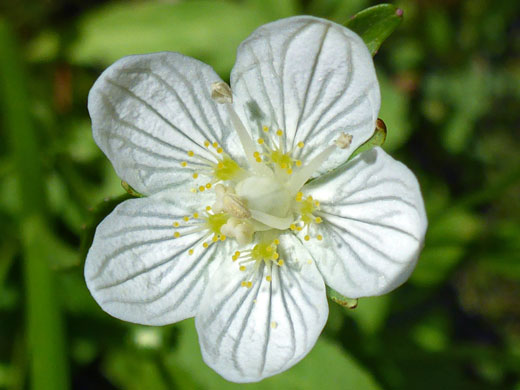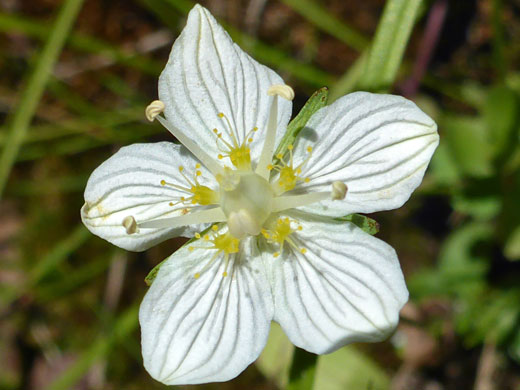Parnassia Palustris, Marsh Grass of Parnassus
Plants > Wildflowers > Celastraceae > Parnassia Palustris
Common name:
Marsh grass of parnassus
Family:
Scientific name:
Parnassia palustris
Main flower color:
Range:
California across to the Rocky Mountain states
Height:
Up to 18 inches
Habitat:
Streambanks, wet meadows, from sea level to 11,500 feet
Leaves:
Hairless, ovate to broadly lanceolate. Blade is 1 to 2 inches long, while stalks are up to 5 inches
Season:
June to October
Leaves of parnassia palustris are basal, on long stalks; they have broad, ovate blades, tapered or heart-shaped at the base. Flowers are produced singly at the top of leafless stalks, which have a pair of small bracts a little way above the middle.
The five sepals are around 0.3 inches long, green, crossed by lighter colored veins, and lacking any obvious lighter-colored margin. The five white petals are between 1.5 and 2 times as long, rounded and unnotched at the tip, with between five and 11 veins, extending nearly to the margin. The sepals are just visible from above, between the petals. At the center of the flower are five stamens, topped by light brown anthers, and alternating with five shorter staminodes (infertile stamens), which are greenish-yellow at the tip, from which project up to 27 tiny filaments, each terminating in a yellow gland.
The five sepals are around 0.3 inches long, green, crossed by lighter colored veins, and lacking any obvious lighter-colored margin. The five white petals are between 1.5 and 2 times as long, rounded and unnotched at the tip, with between five and 11 veins, extending nearly to the margin. The sepals are just visible from above, between the petals. At the center of the flower are five stamens, topped by light brown anthers, and alternating with five shorter staminodes (infertile stamens), which are greenish-yellow at the tip, from which project up to 27 tiny filaments, each terminating in a yellow gland.
All Contents © Copyright The American Southwest | Comments and Questions | Contribute | Site Map





